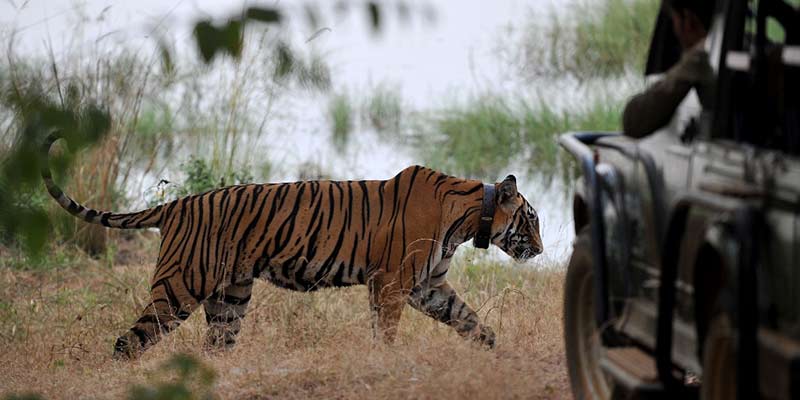- India
- Dec 03
Madhya Pradesh declares Ratapani as Tiger Reserve
• The Madhya Pradesh government has notified Ratapani forest as a tiger reserve in the state.
• It is the eighth tiger reserve in the state after Kanha, Satpura, Bandhavgarh, Pench, Sanjay Dubri, Panna and Veerangana Durgavati.
• It will be the 57th tiger reserve of the country.
• As per the ‘Status of Tigers: Co-predators & Prey in India-2022’ report released by the NTCA and Wildlife Institute of India, the tiger population in Madhya Pradesh is estimated to be 785, the highest in the country, followed by Karnataka (563) and Uttarakhand (560).
• With the formation of the tiger reserve, wildlife can be managed in a better way by receiving a budget from the National Tiger Conservation Authority (NTCA).
Ratapani Tiger Sanctuary
• Ratapani Tiger Sanctuary is situated in the Vindhya Mountain Range across Raisen and Sehore districts of Madhya Pradesh, adjoining state capital Bhopal.
• The sanctuary was first notified in 1976 and then extended in 1983.
• The sanctuary encompasses a World Heritage Site ‘Bhimbetka Rock Shelters’ and many other historical and religious destinations like Ginnorgarh Fort, Keri Mahadeo, Ratapani dam, Jholiyapur dam etc.
• The total area of the Ratapani Tiger Reserve will be 1,271.465 square kilometres.
• It has a core area of 763.812 sq km and buffer area of 507.653 sq km.
• Nine villages, geographically located in the tiger reserve, are not included in the core area in the notification of the sanctuary.
• With the formation of the Ratapani Tiger Reserve, its entire core area is within the boundary of the Ratapani Tiger Sanctuary. This will not change the current rights of the villagers.
Project Tiger
• In 1973, the Project Tiger was established with the objective of utilising the tiger’s functional role and charisma to garner public support and resources for preserving representative ecosystems.
• Project Tiger is an ongoing centrally sponsored scheme of the ministry of environment, forests and climate change providing central assistance to the tiger states for tiger conservation in designated tiger reserves.
• Since its inception, the project has expanded from nine tiger reserves to 57.
• The tiger reserves are constituted on a core/buffer strategy. The core areas have the legal status of a national park or a sanctuary, whereas the buffer or peripheral areas are a mix of forest and non-forest land, managed as a multiple use area.
• Most tiger reserves and protected areas in India are existing as small islands in a vast sea of ecologically unsustainable land use, and many tiger populations are confined to small protected areas. Although some habitat corridors exist that allow tiger movement between them, most of these habitats are not protected areas, continue to deteriorate further due to unsustainable human use and developmental projects, and thereby are not conducive to animal movement.
• Project Tiger aims to foster an exclusive tiger agenda in the core areas of tiger reserves, with an inclusive people oriented agenda in the buffer.
• The conservation of tigers in India can be divided into two phases. The first phase starting in the 1970s, involved the enactment of the Wildlife Protection Act and the establishment of protected areas that helped conserve tigers and tropical forest ecosystems.
• However, in the 1980s, the trade in tiger parts began to decimate the population, leading to a shocking revelation of local extinction of Tigers in the Sariska Tiger Reserve in 2005 and thus began the second phase.
• The second phase began in 2005-06, with the government adopting a landscape-level approach and implementing strict monitoring for tiger conservation.
Challenges for tiger conservation
• Despite efforts to conserve tigers, there are still several challenges that need to be addressed.
• One of the major challenges is aligning the aspirations of large-scale economic development while safeguarding forests and their wildlife and mitigating human-tiger conflict.
• Other silent and surmounting threats are climate change-related impacts on habitats and the loss of the quality of forests over time.
• Out of the approximately 400,000 sqkm of forests in tiger states, only one-third are in relatively healthier condition.
• Another significant challenge is the illegal wildlife trade. Even though poaching is illegal, the demand for tiger products remains high, and poachers continue to kill tigers for profit.
• To combat this, the Indian government has implemented strict laws and increased surveillance to prevent poaching and illegal trade.
• To ensure the long-term survival of tigers in India, a multi-faceted approach is needed, including protecting and expanding tiger habitats, preserving population connectivity, minimising human-tiger conflicts, and combating threats like habitat loss, poaching, and illegal trade.
• It is important to restore habitats, increase ungulate populations, and plan reintroduction of tigers in low density areas to tackle conflict issues.
• The involvement of various stakeholders, such as governments, NGOs, local communities, and businesses, is crucial.
• Strategies like increased patrolling, monitoring, and law enforcement, focus on “Other Effective Area-based Conservation Measures (OECM)” along with promoting eco-tourism and sustainable livelihoods for local communities, can help achieve this goal.
Manorama Yearbook app is now available on Google Play Store and iOS App Store


